Exploring Tourism Trends, Systems, and Economic Impacts in Australia
VerifiedAdded on 2023/06/11
|11
|3326
|465
Homework Assignment
AI Summary
This assignment delves into various aspects of tourism, starting with an identification of current trends in global and Australian tourism, including growth rates, time poverty, and consumer buoyancy. It discusses the tourism system, emphasizing its human, geographical, and industrial elements, and its components such as tourists, destinations, and the tourism industry. The assignment further explores the economic impacts of tourism, differentiating between direct, indirect, and induced effects, and provides an overview of tourism's contribution to the Australian economy, highlighting key destinations and visitor statistics. It also elucidates the concept of Total Economic Value (TEV) and its relevance to tourism management, distinguishing between user and non-user values. Finally, the assignment addresses whether international tourism has helped reduce regional economic disparity in China, concluding that significant disparities persist despite tourism's growth.
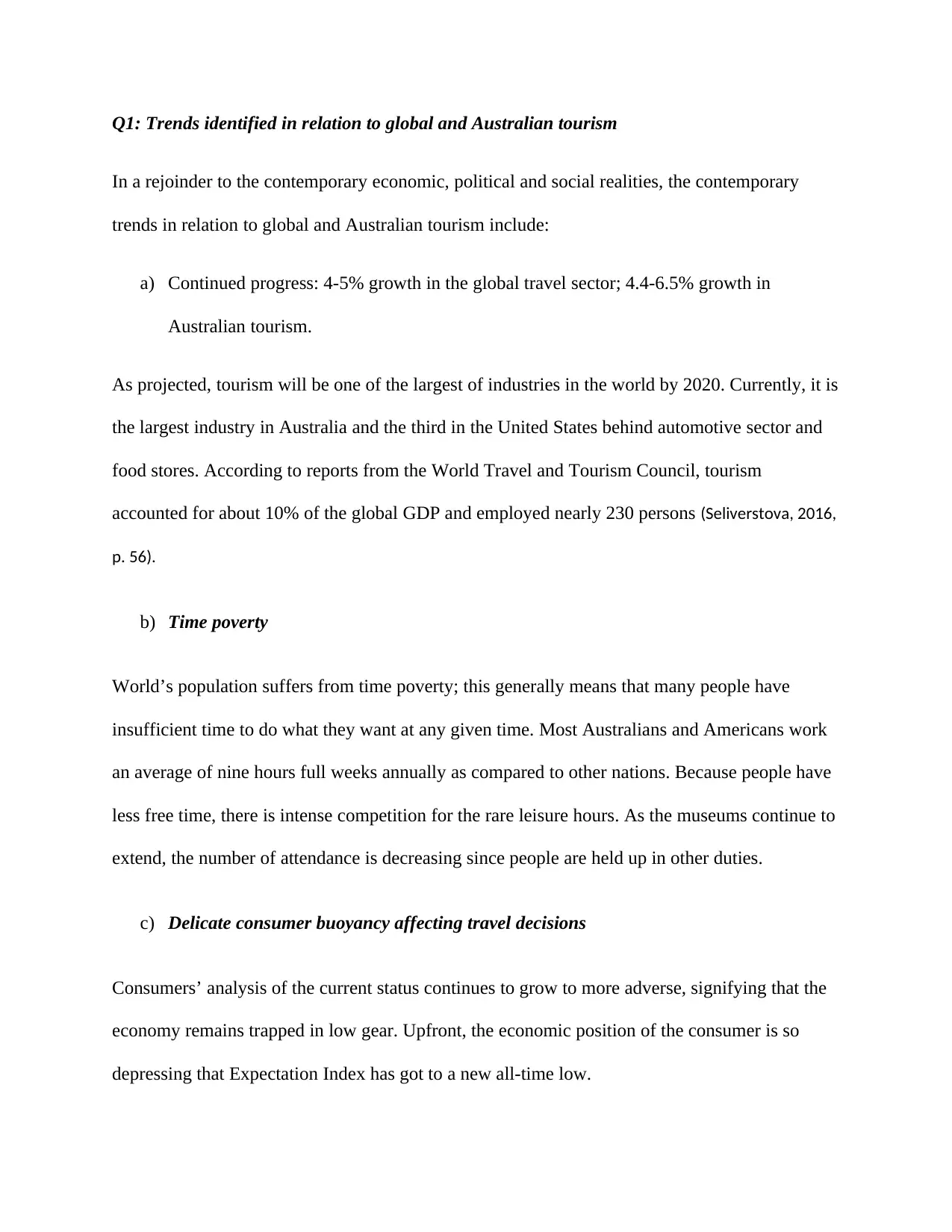
Q1: Trends identified in relation to global and Australian tourism
In a rejoinder to the contemporary economic, political and social realities, the contemporary
trends in relation to global and Australian tourism include:
a) Continued progress: 4-5% growth in the global travel sector; 4.4-6.5% growth in
Australian tourism.
As projected, tourism will be one of the largest of industries in the world by 2020. Currently, it is
the largest industry in Australia and the third in the United States behind automotive sector and
food stores. According to reports from the World Travel and Tourism Council, tourism
accounted for about 10% of the global GDP and employed nearly 230 persons (Seliverstova, 2016,
p. 56).
b) Time poverty
World’s population suffers from time poverty; this generally means that many people have
insufficient time to do what they want at any given time. Most Australians and Americans work
an average of nine hours full weeks annually as compared to other nations. Because people have
less free time, there is intense competition for the rare leisure hours. As the museums continue to
extend, the number of attendance is decreasing since people are held up in other duties.
c) Delicate consumer buoyancy affecting travel decisions
Consumers’ analysis of the current status continues to grow to more adverse, signifying that the
economy remains trapped in low gear. Upfront, the economic position of the consumer is so
depressing that Expectation Index has got to a new all-time low.
In a rejoinder to the contemporary economic, political and social realities, the contemporary
trends in relation to global and Australian tourism include:
a) Continued progress: 4-5% growth in the global travel sector; 4.4-6.5% growth in
Australian tourism.
As projected, tourism will be one of the largest of industries in the world by 2020. Currently, it is
the largest industry in Australia and the third in the United States behind automotive sector and
food stores. According to reports from the World Travel and Tourism Council, tourism
accounted for about 10% of the global GDP and employed nearly 230 persons (Seliverstova, 2016,
p. 56).
b) Time poverty
World’s population suffers from time poverty; this generally means that many people have
insufficient time to do what they want at any given time. Most Australians and Americans work
an average of nine hours full weeks annually as compared to other nations. Because people have
less free time, there is intense competition for the rare leisure hours. As the museums continue to
extend, the number of attendance is decreasing since people are held up in other duties.
c) Delicate consumer buoyancy affecting travel decisions
Consumers’ analysis of the current status continues to grow to more adverse, signifying that the
economy remains trapped in low gear. Upfront, the economic position of the consumer is so
depressing that Expectation Index has got to a new all-time low.
Paraphrase This Document
Need a fresh take? Get an instant paraphrase of this document with our AI Paraphraser
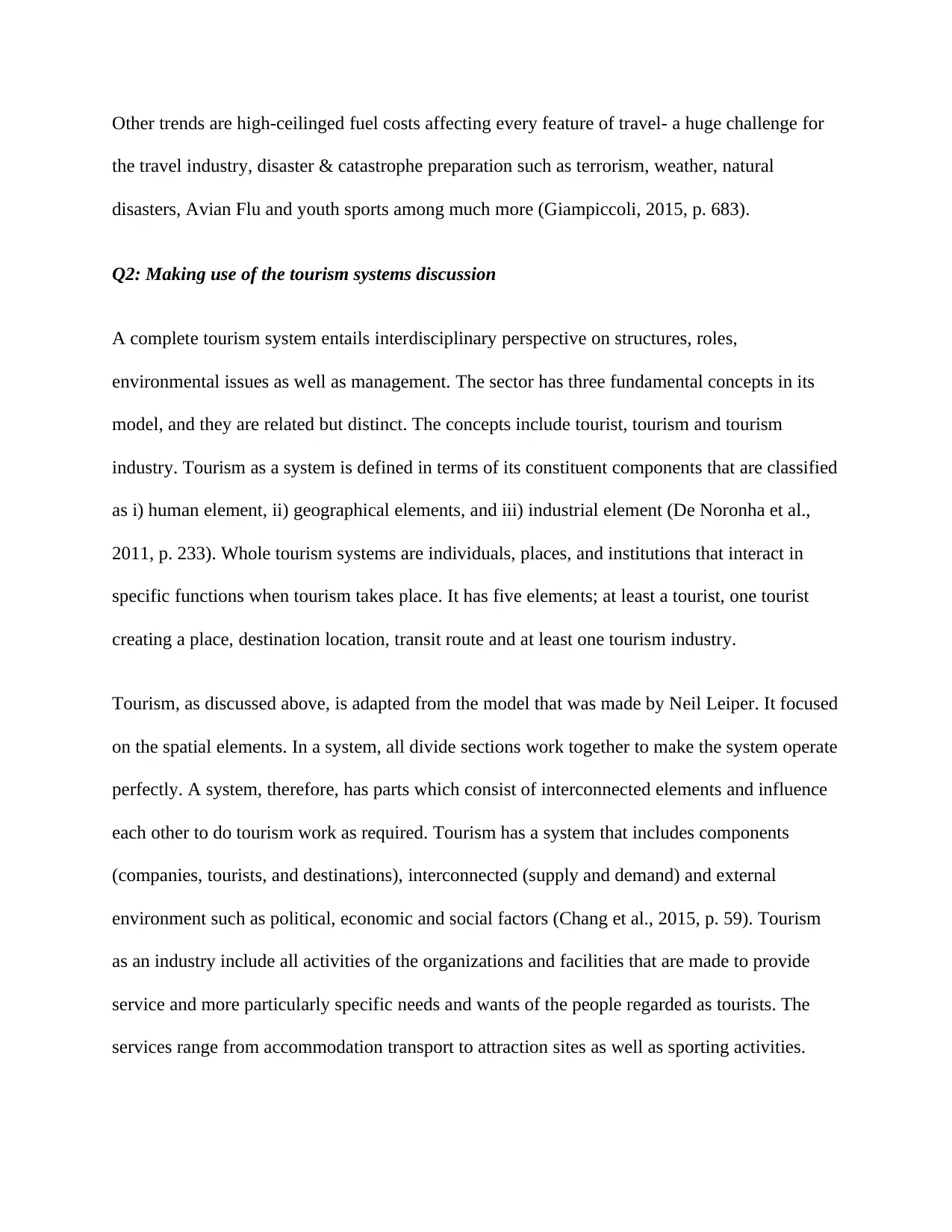
Other trends are high-ceilinged fuel costs affecting every feature of travel- a huge challenge for
the travel industry, disaster & catastrophe preparation such as terrorism, weather, natural
disasters, Avian Flu and youth sports among much more (Giampiccoli, 2015, p. 683).
Q2: Making use of the tourism systems discussion
A complete tourism system entails interdisciplinary perspective on structures, roles,
environmental issues as well as management. The sector has three fundamental concepts in its
model, and they are related but distinct. The concepts include tourist, tourism and tourism
industry. Tourism as a system is defined in terms of its constituent components that are classified
as i) human element, ii) geographical elements, and iii) industrial element (De Noronha et al.,
2011, p. 233). Whole tourism systems are individuals, places, and institutions that interact in
specific functions when tourism takes place. It has five elements; at least a tourist, one tourist
creating a place, destination location, transit route and at least one tourism industry.
Tourism, as discussed above, is adapted from the model that was made by Neil Leiper. It focused
on the spatial elements. In a system, all divide sections work together to make the system operate
perfectly. A system, therefore, has parts which consist of interconnected elements and influence
each other to do tourism work as required. Tourism has a system that includes components
(companies, tourists, and destinations), interconnected (supply and demand) and external
environment such as political, economic and social factors (Chang et al., 2015, p. 59). Tourism
as an industry include all activities of the organizations and facilities that are made to provide
service and more particularly specific needs and wants of the people regarded as tourists. The
services range from accommodation transport to attraction sites as well as sporting activities.
the travel industry, disaster & catastrophe preparation such as terrorism, weather, natural
disasters, Avian Flu and youth sports among much more (Giampiccoli, 2015, p. 683).
Q2: Making use of the tourism systems discussion
A complete tourism system entails interdisciplinary perspective on structures, roles,
environmental issues as well as management. The sector has three fundamental concepts in its
model, and they are related but distinct. The concepts include tourist, tourism and tourism
industry. Tourism as a system is defined in terms of its constituent components that are classified
as i) human element, ii) geographical elements, and iii) industrial element (De Noronha et al.,
2011, p. 233). Whole tourism systems are individuals, places, and institutions that interact in
specific functions when tourism takes place. It has five elements; at least a tourist, one tourist
creating a place, destination location, transit route and at least one tourism industry.
Tourism, as discussed above, is adapted from the model that was made by Neil Leiper. It focused
on the spatial elements. In a system, all divide sections work together to make the system operate
perfectly. A system, therefore, has parts which consist of interconnected elements and influence
each other to do tourism work as required. Tourism has a system that includes components
(companies, tourists, and destinations), interconnected (supply and demand) and external
environment such as political, economic and social factors (Chang et al., 2015, p. 59). Tourism
as an industry include all activities of the organizations and facilities that are made to provide
service and more particularly specific needs and wants of the people regarded as tourists. The
services range from accommodation transport to attraction sites as well as sporting activities.
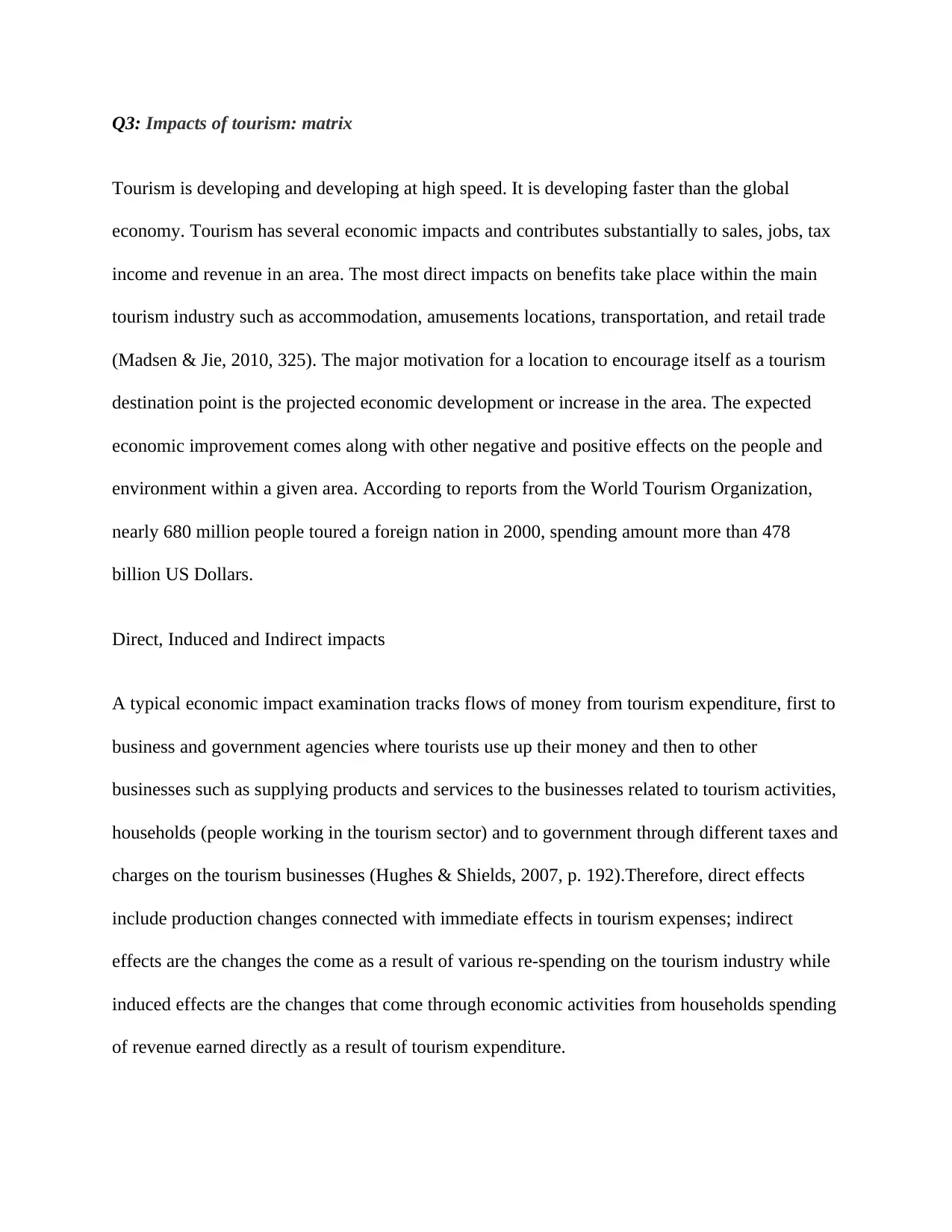
Q3: Impacts of tourism: matrix
Tourism is developing and developing at high speed. It is developing faster than the global
economy. Tourism has several economic impacts and contributes substantially to sales, jobs, tax
income and revenue in an area. The most direct impacts on benefits take place within the main
tourism industry such as accommodation, amusements locations, transportation, and retail trade
(Madsen & Jie, 2010, 325). The major motivation for a location to encourage itself as a tourism
destination point is the projected economic development or increase in the area. The expected
economic improvement comes along with other negative and positive effects on the people and
environment within a given area. According to reports from the World Tourism Organization,
nearly 680 million people toured a foreign nation in 2000, spending amount more than 478
billion US Dollars.
Direct, Induced and Indirect impacts
A typical economic impact examination tracks flows of money from tourism expenditure, first to
business and government agencies where tourists use up their money and then to other
businesses such as supplying products and services to the businesses related to tourism activities,
households (people working in the tourism sector) and to government through different taxes and
charges on the tourism businesses (Hughes & Shields, 2007, p. 192).Therefore, direct effects
include production changes connected with immediate effects in tourism expenses; indirect
effects are the changes the come as a result of various re-spending on the tourism industry while
induced effects are the changes that come through economic activities from households spending
of revenue earned directly as a result of tourism expenditure.
Tourism is developing and developing at high speed. It is developing faster than the global
economy. Tourism has several economic impacts and contributes substantially to sales, jobs, tax
income and revenue in an area. The most direct impacts on benefits take place within the main
tourism industry such as accommodation, amusements locations, transportation, and retail trade
(Madsen & Jie, 2010, 325). The major motivation for a location to encourage itself as a tourism
destination point is the projected economic development or increase in the area. The expected
economic improvement comes along with other negative and positive effects on the people and
environment within a given area. According to reports from the World Tourism Organization,
nearly 680 million people toured a foreign nation in 2000, spending amount more than 478
billion US Dollars.
Direct, Induced and Indirect impacts
A typical economic impact examination tracks flows of money from tourism expenditure, first to
business and government agencies where tourists use up their money and then to other
businesses such as supplying products and services to the businesses related to tourism activities,
households (people working in the tourism sector) and to government through different taxes and
charges on the tourism businesses (Hughes & Shields, 2007, p. 192).Therefore, direct effects
include production changes connected with immediate effects in tourism expenses; indirect
effects are the changes the come as a result of various re-spending on the tourism industry while
induced effects are the changes that come through economic activities from households spending
of revenue earned directly as a result of tourism expenditure.
⊘ This is a preview!⊘
Do you want full access?
Subscribe today to unlock all pages.

Trusted by 1+ million students worldwide
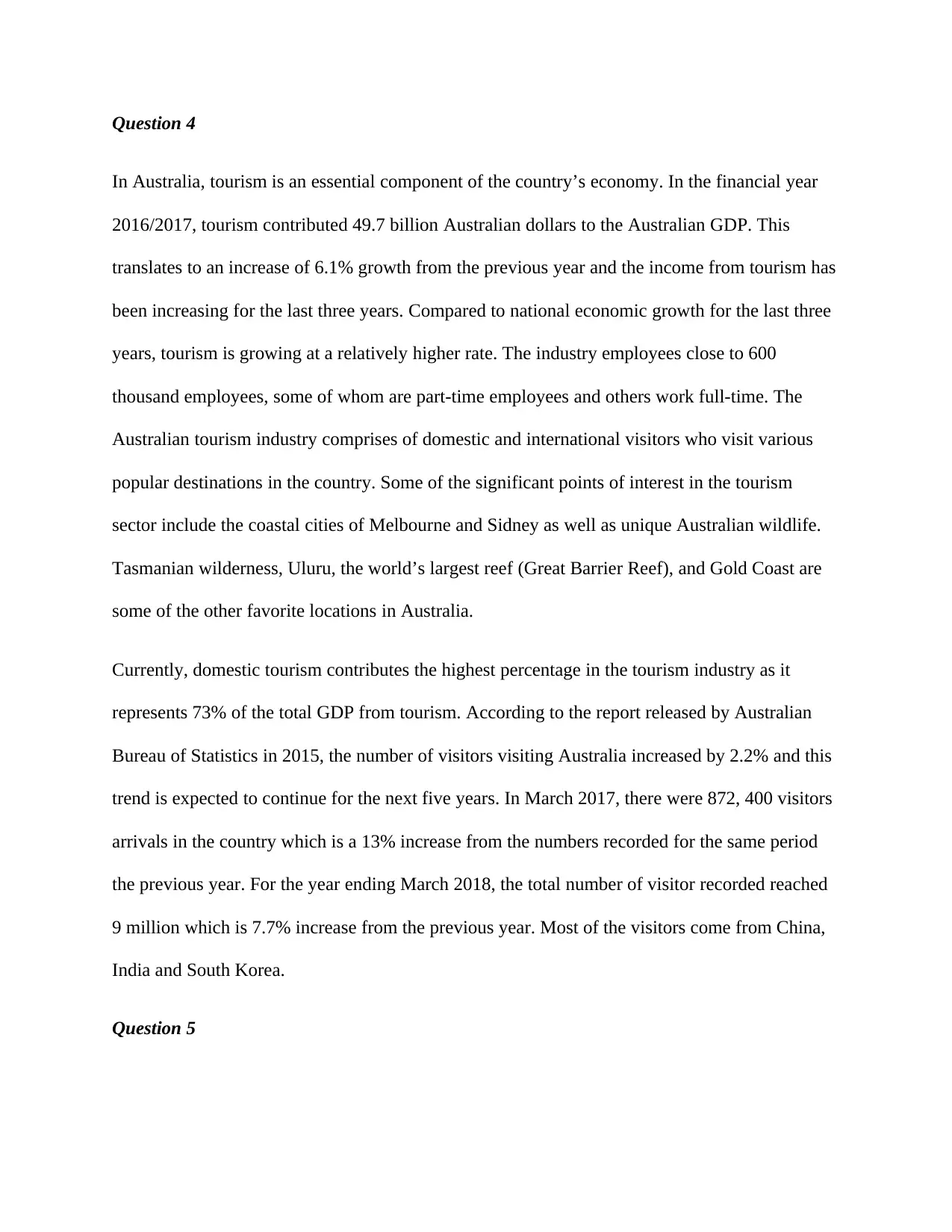
Question 4
In Australia, tourism is an essential component of the country’s economy. In the financial year
2016/2017, tourism contributed 49.7 billion Australian dollars to the Australian GDP. This
translates to an increase of 6.1% growth from the previous year and the income from tourism has
been increasing for the last three years. Compared to national economic growth for the last three
years, tourism is growing at a relatively higher rate. The industry employees close to 600
thousand employees, some of whom are part-time employees and others work full-time. The
Australian tourism industry comprises of domestic and international visitors who visit various
popular destinations in the country. Some of the significant points of interest in the tourism
sector include the coastal cities of Melbourne and Sidney as well as unique Australian wildlife.
Tasmanian wilderness, Uluru, the world’s largest reef (Great Barrier Reef), and Gold Coast are
some of the other favorite locations in Australia.
Currently, domestic tourism contributes the highest percentage in the tourism industry as it
represents 73% of the total GDP from tourism. According to the report released by Australian
Bureau of Statistics in 2015, the number of visitors visiting Australia increased by 2.2% and this
trend is expected to continue for the next five years. In March 2017, there were 872, 400 visitors
arrivals in the country which is a 13% increase from the numbers recorded for the same period
the previous year. For the year ending March 2018, the total number of visitor recorded reached
9 million which is 7.7% increase from the previous year. Most of the visitors come from China,
India and South Korea.
Question 5
In Australia, tourism is an essential component of the country’s economy. In the financial year
2016/2017, tourism contributed 49.7 billion Australian dollars to the Australian GDP. This
translates to an increase of 6.1% growth from the previous year and the income from tourism has
been increasing for the last three years. Compared to national economic growth for the last three
years, tourism is growing at a relatively higher rate. The industry employees close to 600
thousand employees, some of whom are part-time employees and others work full-time. The
Australian tourism industry comprises of domestic and international visitors who visit various
popular destinations in the country. Some of the significant points of interest in the tourism
sector include the coastal cities of Melbourne and Sidney as well as unique Australian wildlife.
Tasmanian wilderness, Uluru, the world’s largest reef (Great Barrier Reef), and Gold Coast are
some of the other favorite locations in Australia.
Currently, domestic tourism contributes the highest percentage in the tourism industry as it
represents 73% of the total GDP from tourism. According to the report released by Australian
Bureau of Statistics in 2015, the number of visitors visiting Australia increased by 2.2% and this
trend is expected to continue for the next five years. In March 2017, there were 872, 400 visitors
arrivals in the country which is a 13% increase from the numbers recorded for the same period
the previous year. For the year ending March 2018, the total number of visitor recorded reached
9 million which is 7.7% increase from the previous year. Most of the visitors come from China,
India and South Korea.
Question 5
Paraphrase This Document
Need a fresh take? Get an instant paraphrase of this document with our AI Paraphraser
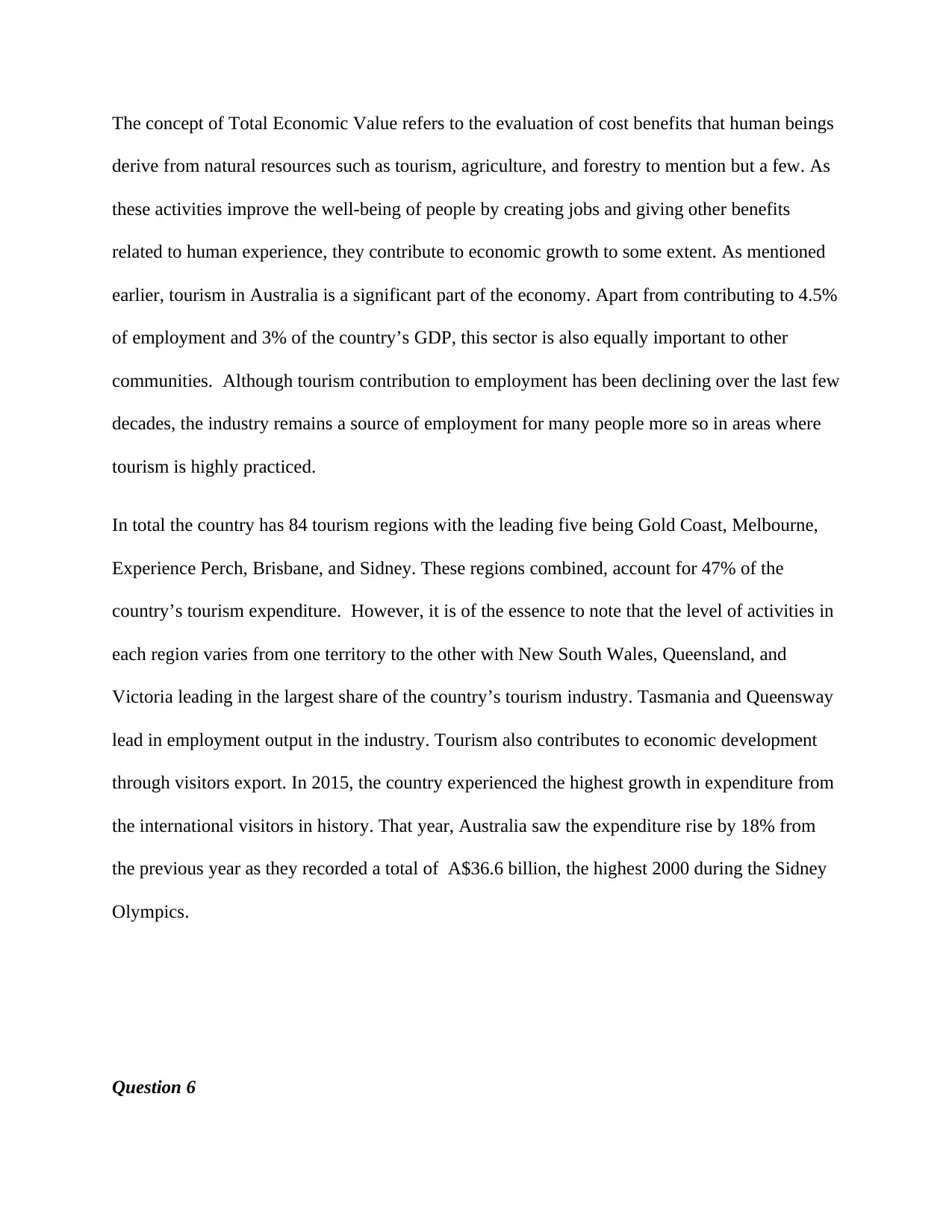
The concept of Total Economic Value refers to the evaluation of cost benefits that human beings
derive from natural resources such as tourism, agriculture, and forestry to mention but a few. As
these activities improve the well-being of people by creating jobs and giving other benefits
related to human experience, they contribute to economic growth to some extent. As mentioned
earlier, tourism in Australia is a significant part of the economy. Apart from contributing to 4.5%
of employment and 3% of the country’s GDP, this sector is also equally important to other
communities. Although tourism contribution to employment has been declining over the last few
decades, the industry remains a source of employment for many people more so in areas where
tourism is highly practiced.
In total the country has 84 tourism regions with the leading five being Gold Coast, Melbourne,
Experience Perch, Brisbane, and Sidney. These regions combined, account for 47% of the
country’s tourism expenditure. However, it is of the essence to note that the level of activities in
each region varies from one territory to the other with New South Wales, Queensland, and
Victoria leading in the largest share of the country’s tourism industry. Tasmania and Queensway
lead in employment output in the industry. Tourism also contributes to economic development
through visitors export. In 2015, the country experienced the highest growth in expenditure from
the international visitors in history. That year, Australia saw the expenditure rise by 18% from
the previous year as they recorded a total of A$36.6 billion, the highest 2000 during the Sidney
Olympics.
Question 6
derive from natural resources such as tourism, agriculture, and forestry to mention but a few. As
these activities improve the well-being of people by creating jobs and giving other benefits
related to human experience, they contribute to economic growth to some extent. As mentioned
earlier, tourism in Australia is a significant part of the economy. Apart from contributing to 4.5%
of employment and 3% of the country’s GDP, this sector is also equally important to other
communities. Although tourism contribution to employment has been declining over the last few
decades, the industry remains a source of employment for many people more so in areas where
tourism is highly practiced.
In total the country has 84 tourism regions with the leading five being Gold Coast, Melbourne,
Experience Perch, Brisbane, and Sidney. These regions combined, account for 47% of the
country’s tourism expenditure. However, it is of the essence to note that the level of activities in
each region varies from one territory to the other with New South Wales, Queensland, and
Victoria leading in the largest share of the country’s tourism industry. Tasmania and Queensway
lead in employment output in the industry. Tourism also contributes to economic development
through visitors export. In 2015, the country experienced the highest growth in expenditure from
the international visitors in history. That year, Australia saw the expenditure rise by 18% from
the previous year as they recorded a total of A$36.6 billion, the highest 2000 during the Sidney
Olympics.
Question 6
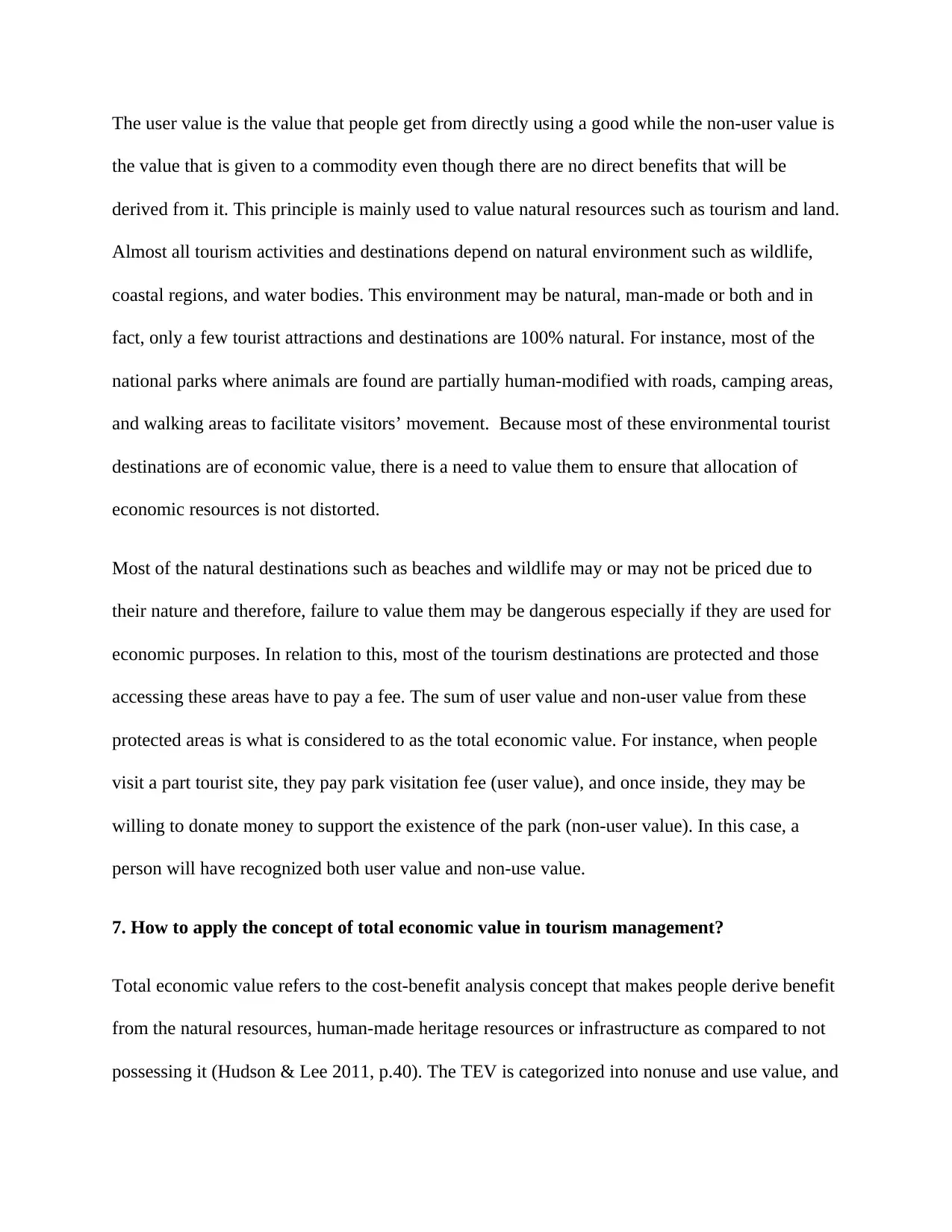
The user value is the value that people get from directly using a good while the non-user value is
the value that is given to a commodity even though there are no direct benefits that will be
derived from it. This principle is mainly used to value natural resources such as tourism and land.
Almost all tourism activities and destinations depend on natural environment such as wildlife,
coastal regions, and water bodies. This environment may be natural, man-made or both and in
fact, only a few tourist attractions and destinations are 100% natural. For instance, most of the
national parks where animals are found are partially human-modified with roads, camping areas,
and walking areas to facilitate visitors’ movement. Because most of these environmental tourist
destinations are of economic value, there is a need to value them to ensure that allocation of
economic resources is not distorted.
Most of the natural destinations such as beaches and wildlife may or may not be priced due to
their nature and therefore, failure to value them may be dangerous especially if they are used for
economic purposes. In relation to this, most of the tourism destinations are protected and those
accessing these areas have to pay a fee. The sum of user value and non-user value from these
protected areas is what is considered to as the total economic value. For instance, when people
visit a part tourist site, they pay park visitation fee (user value), and once inside, they may be
willing to donate money to support the existence of the park (non-user value). In this case, a
person will have recognized both user value and non-use value.
7. How to apply the concept of total economic value in tourism management?
Total economic value refers to the cost-benefit analysis concept that makes people derive benefit
from the natural resources, human-made heritage resources or infrastructure as compared to not
possessing it (Hudson & Lee 2011, p.40). The TEV is categorized into nonuse and use value, and
the value that is given to a commodity even though there are no direct benefits that will be
derived from it. This principle is mainly used to value natural resources such as tourism and land.
Almost all tourism activities and destinations depend on natural environment such as wildlife,
coastal regions, and water bodies. This environment may be natural, man-made or both and in
fact, only a few tourist attractions and destinations are 100% natural. For instance, most of the
national parks where animals are found are partially human-modified with roads, camping areas,
and walking areas to facilitate visitors’ movement. Because most of these environmental tourist
destinations are of economic value, there is a need to value them to ensure that allocation of
economic resources is not distorted.
Most of the natural destinations such as beaches and wildlife may or may not be priced due to
their nature and therefore, failure to value them may be dangerous especially if they are used for
economic purposes. In relation to this, most of the tourism destinations are protected and those
accessing these areas have to pay a fee. The sum of user value and non-user value from these
protected areas is what is considered to as the total economic value. For instance, when people
visit a part tourist site, they pay park visitation fee (user value), and once inside, they may be
willing to donate money to support the existence of the park (non-user value). In this case, a
person will have recognized both user value and non-use value.
7. How to apply the concept of total economic value in tourism management?
Total economic value refers to the cost-benefit analysis concept that makes people derive benefit
from the natural resources, human-made heritage resources or infrastructure as compared to not
possessing it (Hudson & Lee 2011, p.40). The TEV is categorized into nonuse and use value, and
⊘ This is a preview!⊘
Do you want full access?
Subscribe today to unlock all pages.

Trusted by 1+ million students worldwide
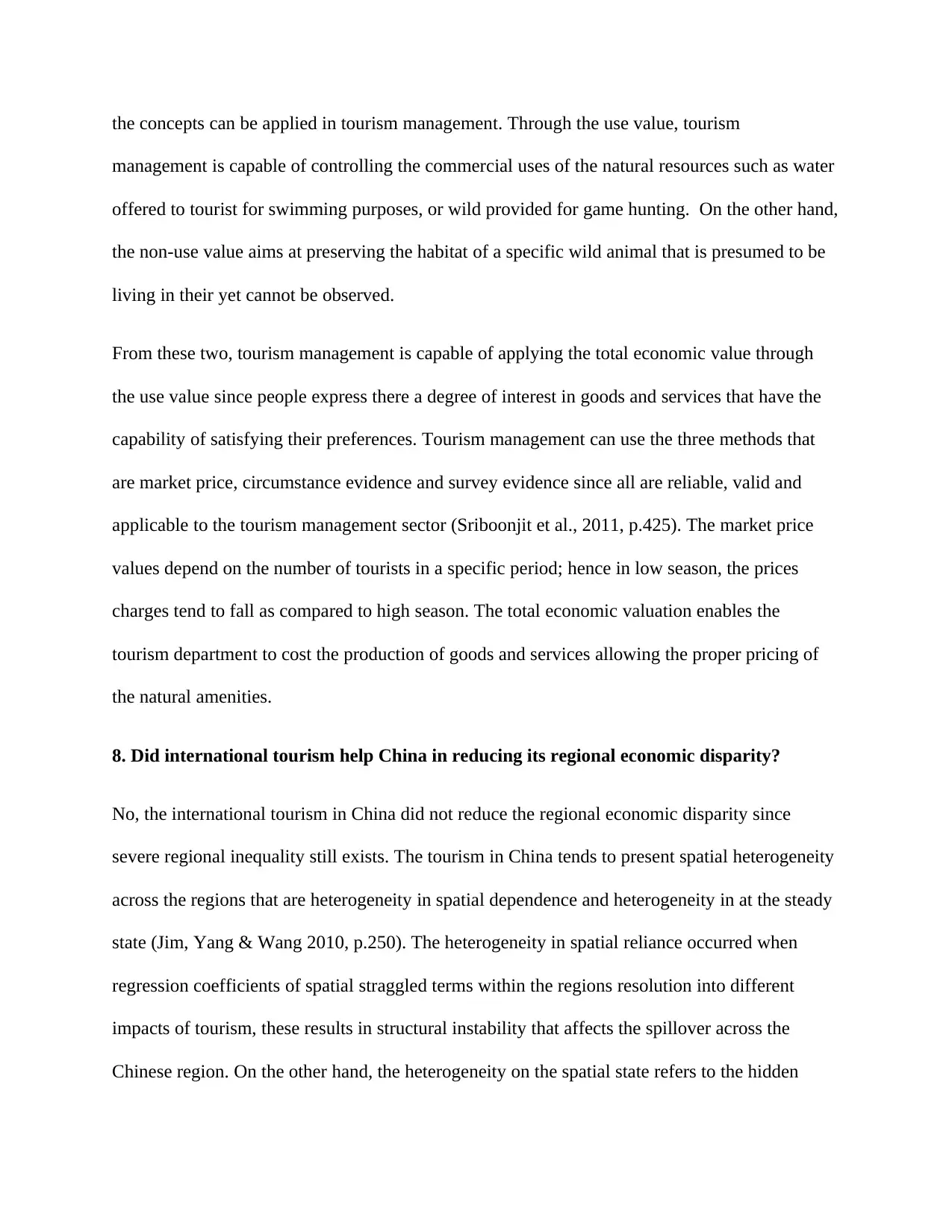
the concepts can be applied in tourism management. Through the use value, tourism
management is capable of controlling the commercial uses of the natural resources such as water
offered to tourist for swimming purposes, or wild provided for game hunting. On the other hand,
the non-use value aims at preserving the habitat of a specific wild animal that is presumed to be
living in their yet cannot be observed.
From these two, tourism management is capable of applying the total economic value through
the use value since people express there a degree of interest in goods and services that have the
capability of satisfying their preferences. Tourism management can use the three methods that
are market price, circumstance evidence and survey evidence since all are reliable, valid and
applicable to the tourism management sector (Sriboonjit et al., 2011, p.425). The market price
values depend on the number of tourists in a specific period; hence in low season, the prices
charges tend to fall as compared to high season. The total economic valuation enables the
tourism department to cost the production of goods and services allowing the proper pricing of
the natural amenities.
8. Did international tourism help China in reducing its regional economic disparity?
No, the international tourism in China did not reduce the regional economic disparity since
severe regional inequality still exists. The tourism in China tends to present spatial heterogeneity
across the regions that are heterogeneity in spatial dependence and heterogeneity in at the steady
state (Jim, Yang & Wang 2010, p.250). The heterogeneity in spatial reliance occurred when
regression coefficients of spatial straggled terms within the regions resolution into different
impacts of tourism, these results in structural instability that affects the spillover across the
Chinese region. On the other hand, the heterogeneity on the spatial state refers to the hidden
management is capable of controlling the commercial uses of the natural resources such as water
offered to tourist for swimming purposes, or wild provided for game hunting. On the other hand,
the non-use value aims at preserving the habitat of a specific wild animal that is presumed to be
living in their yet cannot be observed.
From these two, tourism management is capable of applying the total economic value through
the use value since people express there a degree of interest in goods and services that have the
capability of satisfying their preferences. Tourism management can use the three methods that
are market price, circumstance evidence and survey evidence since all are reliable, valid and
applicable to the tourism management sector (Sriboonjit et al., 2011, p.425). The market price
values depend on the number of tourists in a specific period; hence in low season, the prices
charges tend to fall as compared to high season. The total economic valuation enables the
tourism department to cost the production of goods and services allowing the proper pricing of
the natural amenities.
8. Did international tourism help China in reducing its regional economic disparity?
No, the international tourism in China did not reduce the regional economic disparity since
severe regional inequality still exists. The tourism in China tends to present spatial heterogeneity
across the regions that are heterogeneity in spatial dependence and heterogeneity in at the steady
state (Jim, Yang & Wang 2010, p.250). The heterogeneity in spatial reliance occurred when
regression coefficients of spatial straggled terms within the regions resolution into different
impacts of tourism, these results in structural instability that affects the spillover across the
Chinese region. On the other hand, the heterogeneity on the spatial state refers to the hidden
Paraphrase This Document
Need a fresh take? Get an instant paraphrase of this document with our AI Paraphraser
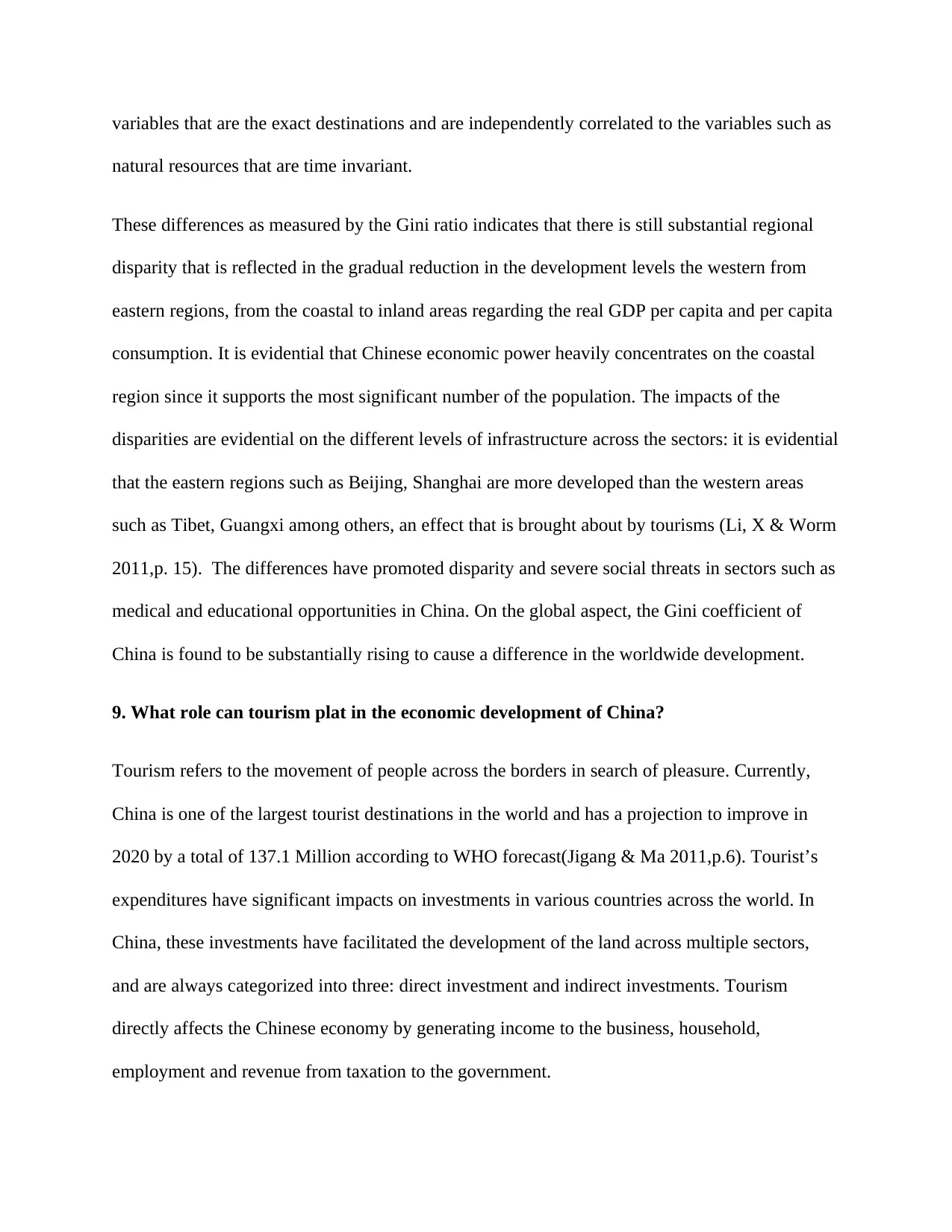
variables that are the exact destinations and are independently correlated to the variables such as
natural resources that are time invariant.
These differences as measured by the Gini ratio indicates that there is still substantial regional
disparity that is reflected in the gradual reduction in the development levels the western from
eastern regions, from the coastal to inland areas regarding the real GDP per capita and per capita
consumption. It is evidential that Chinese economic power heavily concentrates on the coastal
region since it supports the most significant number of the population. The impacts of the
disparities are evidential on the different levels of infrastructure across the sectors: it is evidential
that the eastern regions such as Beijing, Shanghai are more developed than the western areas
such as Tibet, Guangxi among others, an effect that is brought about by tourisms (Li, X & Worm
2011,p. 15). The differences have promoted disparity and severe social threats in sectors such as
medical and educational opportunities in China. On the global aspect, the Gini coefficient of
China is found to be substantially rising to cause a difference in the worldwide development.
9. What role can tourism plat in the economic development of China?
Tourism refers to the movement of people across the borders in search of pleasure. Currently,
China is one of the largest tourist destinations in the world and has a projection to improve in
2020 by a total of 137.1 Million according to WHO forecast(Jigang & Ma 2011,p.6). Tourist’s
expenditures have significant impacts on investments in various countries across the world. In
China, these investments have facilitated the development of the land across multiple sectors,
and are always categorized into three: direct investment and indirect investments. Tourism
directly affects the Chinese economy by generating income to the business, household,
employment and revenue from taxation to the government.
natural resources that are time invariant.
These differences as measured by the Gini ratio indicates that there is still substantial regional
disparity that is reflected in the gradual reduction in the development levels the western from
eastern regions, from the coastal to inland areas regarding the real GDP per capita and per capita
consumption. It is evidential that Chinese economic power heavily concentrates on the coastal
region since it supports the most significant number of the population. The impacts of the
disparities are evidential on the different levels of infrastructure across the sectors: it is evidential
that the eastern regions such as Beijing, Shanghai are more developed than the western areas
such as Tibet, Guangxi among others, an effect that is brought about by tourisms (Li, X & Worm
2011,p. 15). The differences have promoted disparity and severe social threats in sectors such as
medical and educational opportunities in China. On the global aspect, the Gini coefficient of
China is found to be substantially rising to cause a difference in the worldwide development.
9. What role can tourism plat in the economic development of China?
Tourism refers to the movement of people across the borders in search of pleasure. Currently,
China is one of the largest tourist destinations in the world and has a projection to improve in
2020 by a total of 137.1 Million according to WHO forecast(Jigang & Ma 2011,p.6). Tourist’s
expenditures have significant impacts on investments in various countries across the world. In
China, these investments have facilitated the development of the land across multiple sectors,
and are always categorized into three: direct investment and indirect investments. Tourism
directly affects the Chinese economy by generating income to the business, household,
employment and revenue from taxation to the government.
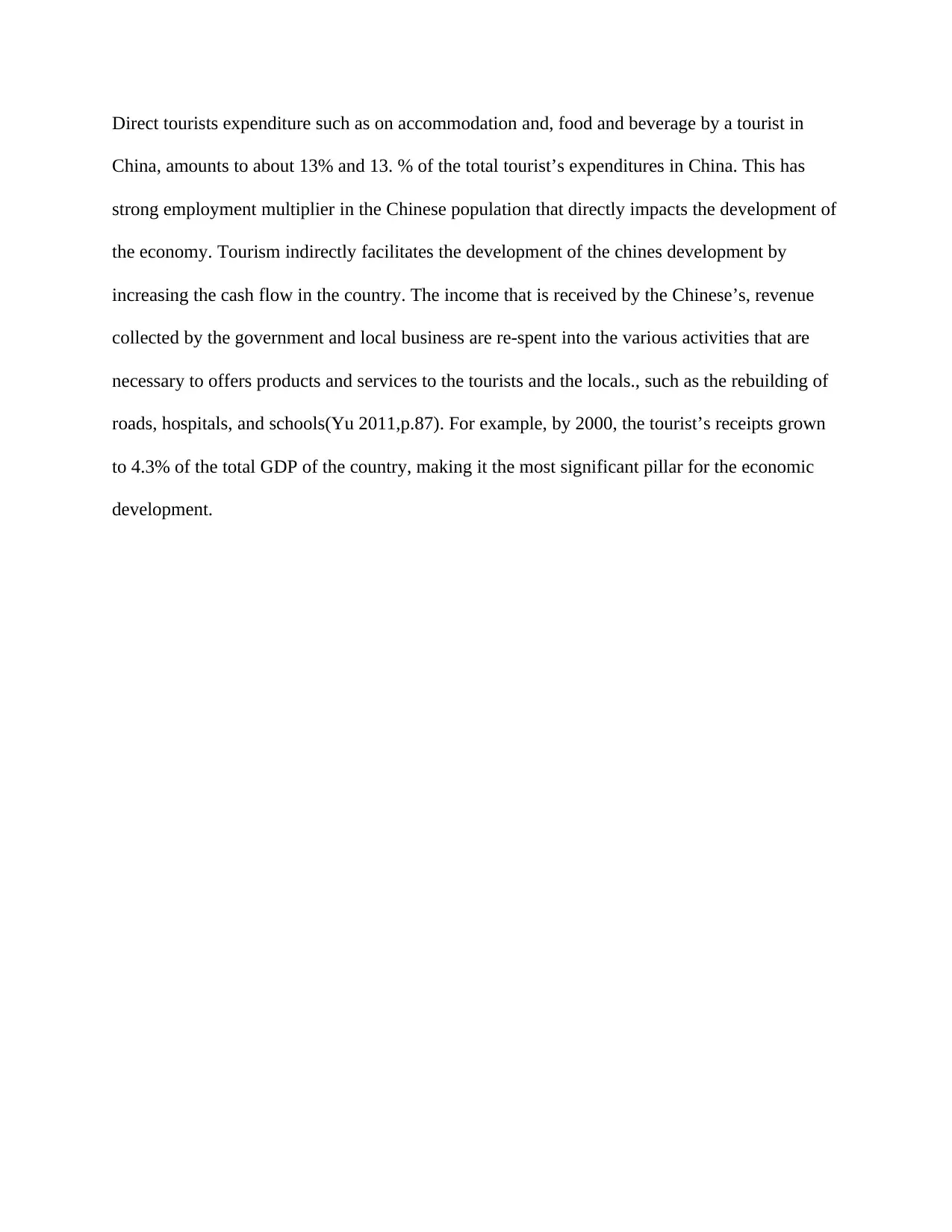
Direct tourists expenditure such as on accommodation and, food and beverage by a tourist in
China, amounts to about 13% and 13. % of the total tourist’s expenditures in China. This has
strong employment multiplier in the Chinese population that directly impacts the development of
the economy. Tourism indirectly facilitates the development of the chines development by
increasing the cash flow in the country. The income that is received by the Chinese’s, revenue
collected by the government and local business are re-spent into the various activities that are
necessary to offers products and services to the tourists and the locals., such as the rebuilding of
roads, hospitals, and schools(Yu 2011,p.87). For example, by 2000, the tourist’s receipts grown
to 4.3% of the total GDP of the country, making it the most significant pillar for the economic
development.
China, amounts to about 13% and 13. % of the total tourist’s expenditures in China. This has
strong employment multiplier in the Chinese population that directly impacts the development of
the economy. Tourism indirectly facilitates the development of the chines development by
increasing the cash flow in the country. The income that is received by the Chinese’s, revenue
collected by the government and local business are re-spent into the various activities that are
necessary to offers products and services to the tourists and the locals., such as the rebuilding of
roads, hospitals, and schools(Yu 2011,p.87). For example, by 2000, the tourist’s receipts grown
to 4.3% of the total GDP of the country, making it the most significant pillar for the economic
development.
⊘ This is a preview!⊘
Do you want full access?
Subscribe today to unlock all pages.

Trusted by 1+ million students worldwide
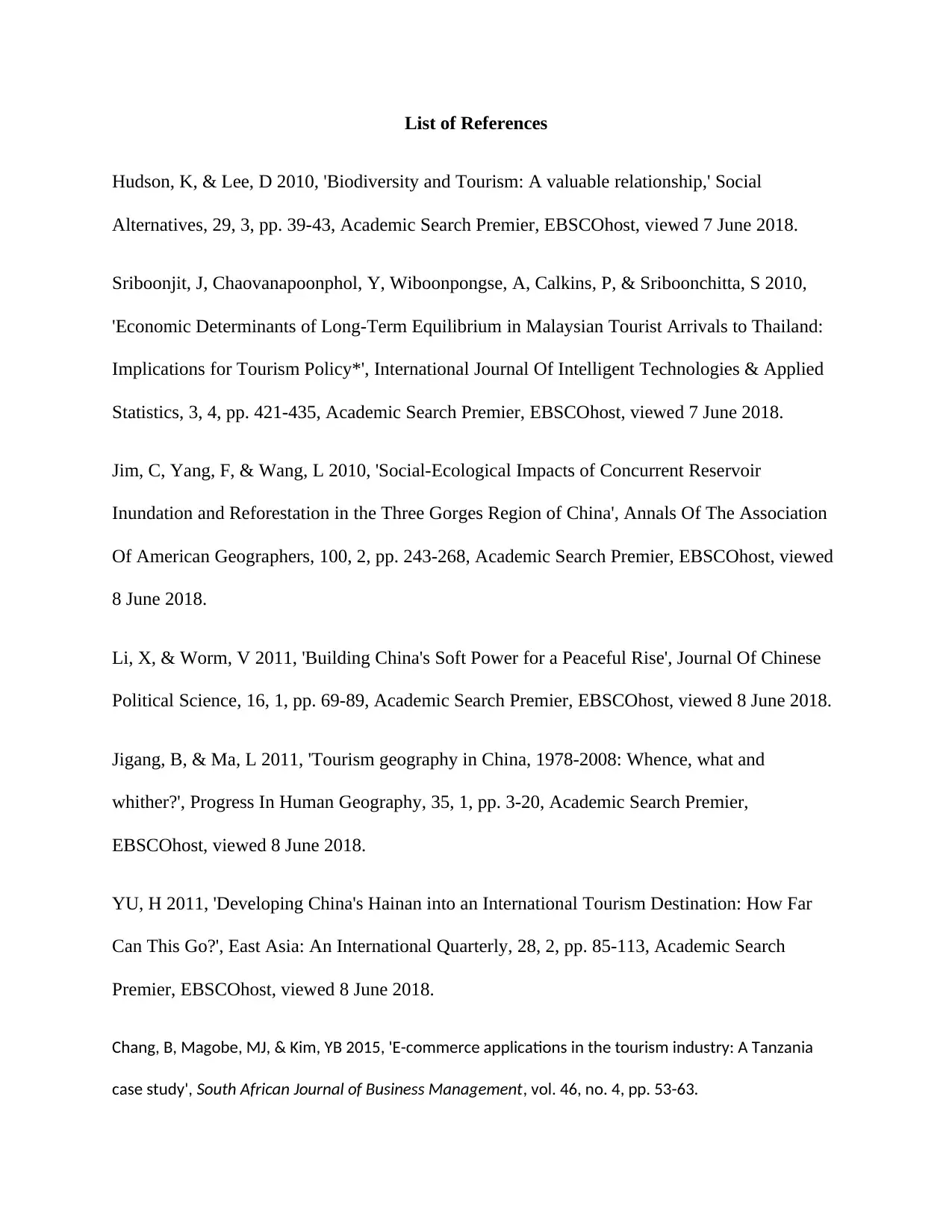
List of References
Hudson, K, & Lee, D 2010, 'Biodiversity and Tourism: A valuable relationship,' Social
Alternatives, 29, 3, pp. 39-43, Academic Search Premier, EBSCOhost, viewed 7 June 2018.
Sriboonjit, J, Chaovanapoonphol, Y, Wiboonpongse, A, Calkins, P, & Sriboonchitta, S 2010,
'Economic Determinants of Long-Term Equilibrium in Malaysian Tourist Arrivals to Thailand:
Implications for Tourism Policy*', International Journal Of Intelligent Technologies & Applied
Statistics, 3, 4, pp. 421-435, Academic Search Premier, EBSCOhost, viewed 7 June 2018.
Jim, C, Yang, F, & Wang, L 2010, 'Social-Ecological Impacts of Concurrent Reservoir
Inundation and Reforestation in the Three Gorges Region of China', Annals Of The Association
Of American Geographers, 100, 2, pp. 243-268, Academic Search Premier, EBSCOhost, viewed
8 June 2018.
Li, X, & Worm, V 2011, 'Building China's Soft Power for a Peaceful Rise', Journal Of Chinese
Political Science, 16, 1, pp. 69-89, Academic Search Premier, EBSCOhost, viewed 8 June 2018.
Jigang, B, & Ma, L 2011, 'Tourism geography in China, 1978-2008: Whence, what and
whither?', Progress In Human Geography, 35, 1, pp. 3-20, Academic Search Premier,
EBSCOhost, viewed 8 June 2018.
YU, H 2011, 'Developing China's Hainan into an International Tourism Destination: How Far
Can This Go?', East Asia: An International Quarterly, 28, 2, pp. 85-113, Academic Search
Premier, EBSCOhost, viewed 8 June 2018.
Chang, B, Magobe, MJ, & Kim, YB 2015, 'E-commerce applications in the tourism industry: A Tanzania
case study', South African Journal of Business Management, vol. 46, no. 4, pp. 53-63.
Hudson, K, & Lee, D 2010, 'Biodiversity and Tourism: A valuable relationship,' Social
Alternatives, 29, 3, pp. 39-43, Academic Search Premier, EBSCOhost, viewed 7 June 2018.
Sriboonjit, J, Chaovanapoonphol, Y, Wiboonpongse, A, Calkins, P, & Sriboonchitta, S 2010,
'Economic Determinants of Long-Term Equilibrium in Malaysian Tourist Arrivals to Thailand:
Implications for Tourism Policy*', International Journal Of Intelligent Technologies & Applied
Statistics, 3, 4, pp. 421-435, Academic Search Premier, EBSCOhost, viewed 7 June 2018.
Jim, C, Yang, F, & Wang, L 2010, 'Social-Ecological Impacts of Concurrent Reservoir
Inundation and Reforestation in the Three Gorges Region of China', Annals Of The Association
Of American Geographers, 100, 2, pp. 243-268, Academic Search Premier, EBSCOhost, viewed
8 June 2018.
Li, X, & Worm, V 2011, 'Building China's Soft Power for a Peaceful Rise', Journal Of Chinese
Political Science, 16, 1, pp. 69-89, Academic Search Premier, EBSCOhost, viewed 8 June 2018.
Jigang, B, & Ma, L 2011, 'Tourism geography in China, 1978-2008: Whence, what and
whither?', Progress In Human Geography, 35, 1, pp. 3-20, Academic Search Premier,
EBSCOhost, viewed 8 June 2018.
YU, H 2011, 'Developing China's Hainan into an International Tourism Destination: How Far
Can This Go?', East Asia: An International Quarterly, 28, 2, pp. 85-113, Academic Search
Premier, EBSCOhost, viewed 8 June 2018.
Chang, B, Magobe, MJ, & Kim, YB 2015, 'E-commerce applications in the tourism industry: A Tanzania
case study', South African Journal of Business Management, vol. 46, no. 4, pp. 53-63.
Paraphrase This Document
Need a fresh take? Get an instant paraphrase of this document with our AI Paraphraser
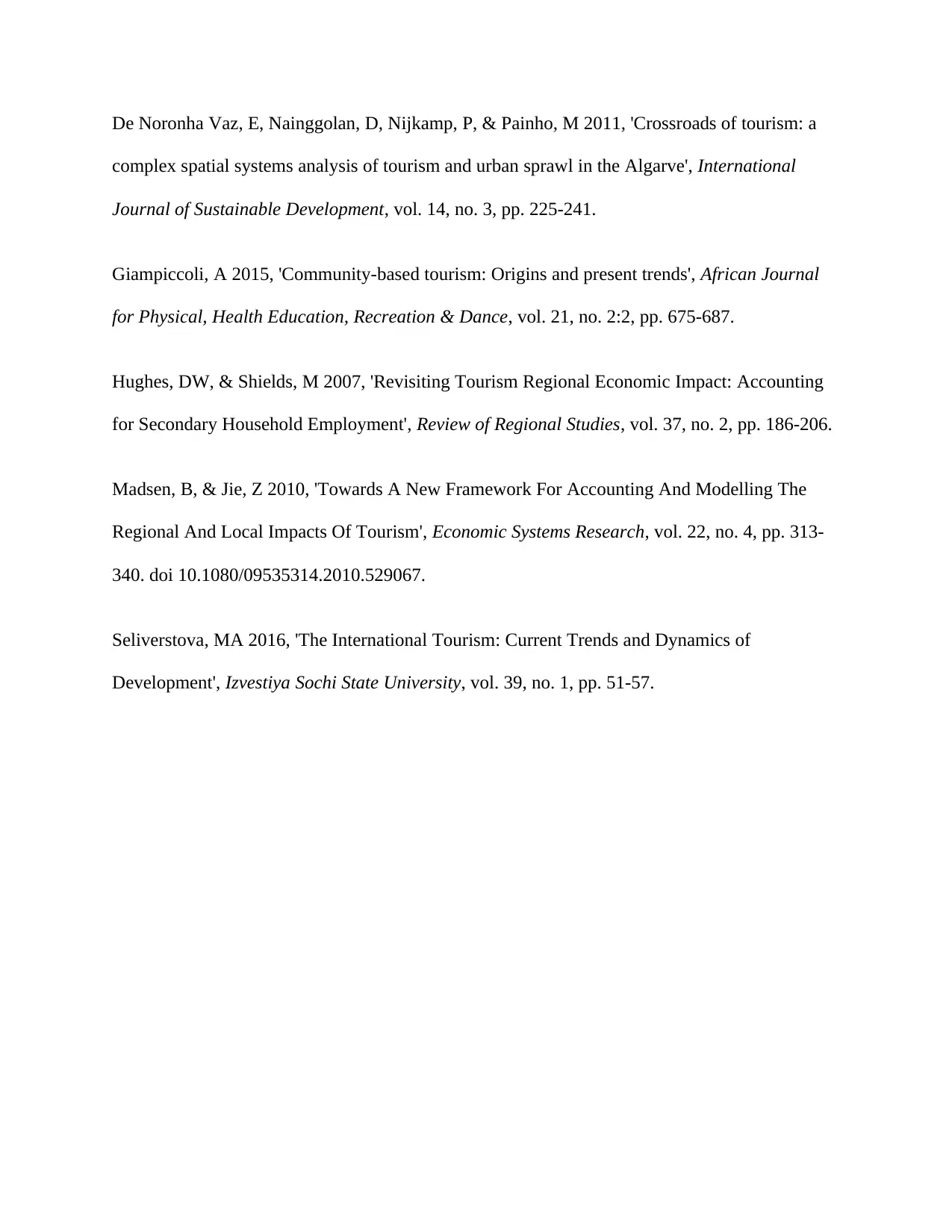
De Noronha Vaz, E, Nainggolan, D, Nijkamp, P, & Painho, M 2011, 'Crossroads of tourism: a
complex spatial systems analysis of tourism and urban sprawl in the Algarve', International
Journal of Sustainable Development, vol. 14, no. 3, pp. 225-241.
Giampiccoli, A 2015, 'Community-based tourism: Origins and present trends', African Journal
for Physical, Health Education, Recreation & Dance, vol. 21, no. 2:2, pp. 675-687.
Hughes, DW, & Shields, M 2007, 'Revisiting Tourism Regional Economic Impact: Accounting
for Secondary Household Employment', Review of Regional Studies, vol. 37, no. 2, pp. 186-206.
Madsen, B, & Jie, Z 2010, 'Towards A New Framework For Accounting And Modelling The
Regional And Local Impacts Of Tourism', Economic Systems Research, vol. 22, no. 4, pp. 313-
340. doi 10.1080/09535314.2010.529067.
Seliverstova, MA 2016, 'The International Tourism: Current Trends and Dynamics of
Development', Izvestiya Sochi State University, vol. 39, no. 1, pp. 51-57.
complex spatial systems analysis of tourism and urban sprawl in the Algarve', International
Journal of Sustainable Development, vol. 14, no. 3, pp. 225-241.
Giampiccoli, A 2015, 'Community-based tourism: Origins and present trends', African Journal
for Physical, Health Education, Recreation & Dance, vol. 21, no. 2:2, pp. 675-687.
Hughes, DW, & Shields, M 2007, 'Revisiting Tourism Regional Economic Impact: Accounting
for Secondary Household Employment', Review of Regional Studies, vol. 37, no. 2, pp. 186-206.
Madsen, B, & Jie, Z 2010, 'Towards A New Framework For Accounting And Modelling The
Regional And Local Impacts Of Tourism', Economic Systems Research, vol. 22, no. 4, pp. 313-
340. doi 10.1080/09535314.2010.529067.
Seliverstova, MA 2016, 'The International Tourism: Current Trends and Dynamics of
Development', Izvestiya Sochi State University, vol. 39, no. 1, pp. 51-57.
1 out of 11
Related Documents
Your All-in-One AI-Powered Toolkit for Academic Success.
+13062052269
info@desklib.com
Available 24*7 on WhatsApp / Email
![[object Object]](/_next/static/media/star-bottom.7253800d.svg)
Unlock your academic potential
Copyright © 2020–2025 A2Z Services. All Rights Reserved. Developed and managed by ZUCOL.




![Presentation: Current Trends in Travel and Tourism - [University Name]](/_next/image/?url=https%3A%2F%2Fdesklib.com%2Fmedia%2Fimages%2Fyp%2F01e078fa0ac04b73bc9b90a7da44b2ff.jpg&w=256&q=75)
